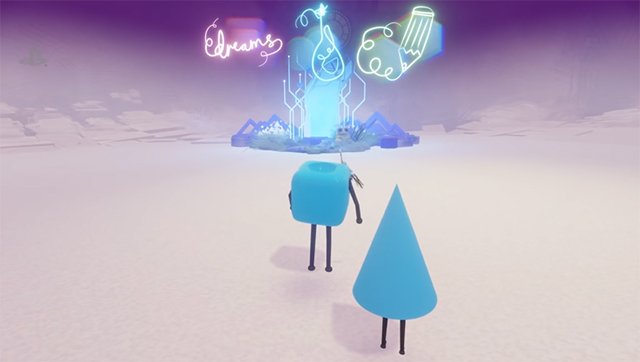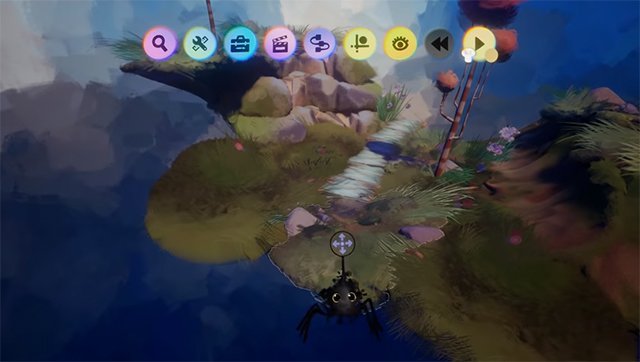Dreams has been about as ethereal as actual dreams. Ever since its early debut as a tech demo at Sony’s PS4 reveal event in February 2013 (yes, it has been that long), developer Media Molecule’s big game hasn’t really made much sense. I couldn’t exactly pinpoint what it would be until I had an extensive hands-on demo during E3 2018. It was a lot to process but after being guided by one of the developers and trying it out myself, I discovered that Dreams was one of the most unique games I’ve played in a long time.
Dreams takes inspiration from LittleBigPlanet by focusing around the “Play, Create, Share” mantra that the game stuck to way back in 2008. But the demo I played was less structured than most games, which made me grateful for my tour guide, Media Molecule Video Editor Dan Castro.
Dreams Preview: Play

Thanks to Castro’s guidance, we dove into the Play section where we played some of Media Molecule’s own creations. These make up the narrative campaign in the game, although Castro was dodgy on the story details. Here, as in some of the other modes in the game, you play as your customizable cursor called an Imp. Using the motion sensor in the PS4 controller to move our Imps, we each possessed weapon-wielding bears, geometrical shapes with legs, and other odd creations.
LittleBigPlanet often drew criticism for its weighty, physics-heavy movement that made jumping feel sluggish; something that can quickly kill a platformer. Later games tried to move away from that but the heft never completely left. In Dreams, nothing I controlled had a similar sense of weight. Each of the creatures I commanded felt responsive in a way most other games play, which immediately made the platforming more satisfying. Snappy jumps and movement speed automatically made Dreams a more enjoyable platformer.
Dreams Preview: Create

Future Shigeru Miyamotos will probably celebrate the improved jumping, granted they even want to make a platformer. We hopped into the creation tools after the introductory levels and I’m glad I was sitting down. Even with Castro’s leadership, it was a lot to process. Menus were buried within menus and it seemed like every possible combination of buttons on the controller did something different. It was initially overwhelming but through my professor Mr. Castro’s trial by fire teaching style, I was able to slowly grasp the basics.
I started moving around geometry, animating platforms, making simple music, implementing visual effects, and throwing down hazards pretty quickly after starting. It felt like a game within a game. This surprised me, given my initial reflex to throw down the controller and briskly walk away from the friendly British man giving me my demo. It would have been impossible to delve into the huge, complicated depths of the many, many menus in the game because each category has almost a dozen or categories under that which also has a few more categories after that.
While my tutorial was a fleshy person, I can only hope the actual in-game tutorials that I didn’t get to see will be comprehensive enough to teach players enough to get them going. While some people will love delving into the nitty gritty parts of the toolset, it may scare off more casual creators. Castro seemed confident that other new artists would pick up the creation suite and make art, just like he did.
“I never made anything interactive in my life,” he admitted. “In two days, I made something in the corner of my office.”
Dreams Preview: Surf

After we made an easy Game of the Year contender in the game’s creation suite, it was on to the Surf playlist. Surfing is like hitting shuffle on your iPod, as it randomly digs through user-generated levels and serves them to you one after another. Since the game isn’t out yet, we only got to play “community” levels made from within Media Molecule so it’s unclear how it’ll grab levels once it has access to the internet’s best (and worst).
If any mode is going to show the flexibility of the tools, it’s the Surfing mode. The sheer creativity and breadth was something that LittleBigPlanet 2 and 3 couldn’t even dream to touch. I played a horror-themed, Limbo-like game; a bizarre, hilarious text adventure; a 3D spaceship shooter combat arena; a platformer reminiscent of Ori and the Will of the Wisps; a video with dancing celery; a music-themed eyeball platformer, and many more levels that kept expanding what I thought was possible inside of Dreams. I almost expected Death Stranding to come up in the constantly cycling levels.
Each experience was impressive in a different way, especially when Castro told me more about what we played. One of Media Molecule’s programmers crafted the text adventure. Their audio designer made the eyeball platformer with thumping club music. An artist at Media Molecule made the gorgeous Ori-like level. He emphasized that these weren’t made by level designers, but just regular creative people who embraced the toolset.
That included Castro himself. Like any proud father, he gleamed with joy when his level titled “Please Hug Me” came up during the shuffle. It starred a little cube with outstretched arms as it tried to move towards a herd of cones and hug them. Every cone slowly backed away from the cube and fell off to their presumed death. The cube remained unhugged as the camera zoomed out and the level ended. It was a hilarious, yet profoundly sad interactive art film that hopefully wasn’t a cry for help from Castro himself.
Unlike my actual dreams, I remembered Dreams long after I walked away from Sony’s secret E3 booth. Through its creation suite and wide range of user-made experiences, it felt like a bottomless toybox that continually made me rethink what this game was truly capable of. Its tools might be too much for some but that’s not a bad thing if it can consistently yield completely new experiences and filter out all the penis swastikas. The 1% of players who make awe-inspiring worlds won’t get to unleash their creativity until this game releases, which, last we heard, is some time in 2018.







